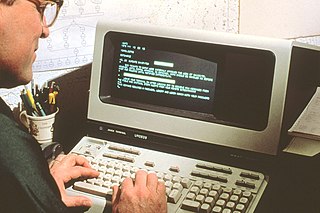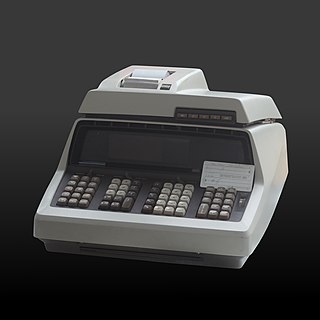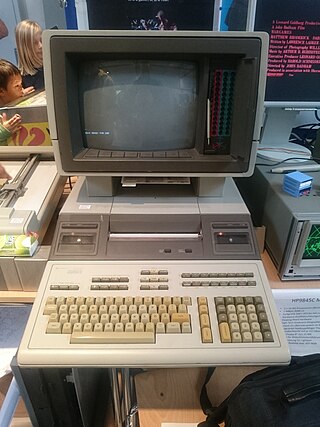
Digital Data Storage (DDS) is a computer data storage technology that is based upon the Digital Audio Tape (DAT) format that was developed during the 1980s. DDS is primarily intended for use as off-line storage, especially for generating backup copies of working data.

Quarter inch cartridge tape is a magnetic tape data storage format introduced by 3M in 1972, with derivatives still in use as of 2016. QIC comes in a rugged enclosed package of aluminum and plastic that holds two tape reels driven by a single belt in direct contact with the tape. The tape was originally 1⁄4 inch (6.35 mm) wide and anywhere from 300 to 1,500 feet long. Data is written linearly along the length of the tape in one track, or written "serpentine", one track at a time, the drive reversing direction at the end of the tape, and each track's data written in the opposite direction to its neighbor. Since its introduction, it has been widely used, and many variations exist. There is a QIC trade association that publishes QIC standards which include interfaces and logical formats. To a very large extent it was the efficiency and openness of this organization which encouraged hardware and software developers to use this type of drive and media.

Linear Tape-Open (LTO), also known as the LTO Ultrium format, is a magnetic tape data storage technology used for backup, data archiving, and data transfer. It was originally developed in the late 1990s as an open standards alternative to the proprietary magnetic tape formats that were available at the time. Upon introduction, LTO rapidly defined the super tape market segment and has consistently been the best-selling super tape format. The latest generation as of 2021, LTO-9, can hold 18 TB in one cartridge.

Travan is an 8 mm magnetic tape cartridge design developed by the 3M company, used for the storage of data in computer backups and mass storage. Over time, subsequent versions of Travan cartridges and drives have been developed that provide greater data capacity, while retaining the standard 8 mm width and 750' length. Travan is standardized under the QIC body. HP Colorado, Iomega DittoMax and AIWA Bolt are proprietary versions of the Travan format.

The HP 2640A and other HP 264X models were block-mode "smart" and intelligent ASCII standard serial terminals produced by Hewlett-Packard using the Intel 8008 and 8080 microprocessors.

The HP 9800 is a family of what were initially called programmable calculators and later desktop computers that were made by Hewlett-Packard, replacing their first HP 9100 calculator. It is also named "98 line". The 9830 and its successors were true computers in the modern sense of the term, complete with a powerful BASIC language interpreter.
Ohio Scientific, Inc., was a privately owned American computer company based in Ohio that built and marketed computer systems, expansions, and software from 1975 to 1986. Their best-known products were the Challenger series of microcomputers and Superboard single-board computers. The company was the first to market microcomputers with hard disk drives in 1977.

9-track tape is a format for magnetic-tape data storage, introduced with the IBM System/360 in 1964. The 1⁄2 inch (12.7 mm) wide magnetic tape media and reels have the same size as the earlier IBM 7-track format it replaced, but the new format has eight data tracks and one parity track for a total of nine parallel tracks. Data is stored as 8-bit characters, spanning the full width of the tape. Various recording methods have been employed during its lifetime as tape speed and data density increased, including PE, GCR, and NRZI. Tapes come in various sizes up to 3,600 feet (1,100 m) in length.
Magnetic-tape data storage is a system for storing digital information on magnetic tape using digital recording.
Archive Corporation was a computer tape drive manufacturer, based in Costa Mesa, California, that was acquired by Conner Peripherals in 1993.

Irwin Magnetic Systems, Inc., also known as Irwin Magnetics, was a computer storage manufacturer founded in 1979 and based in Ann Arbor, Michigan. At its height, the company employed 600 people in Ann Arbor. The company's primary product lines were magnetic tape data storage systems, most popularly the proprietary AccuTrak format. This format was widely adopted by Compaq, Hewlett-Packard and other OEM manufacturers; it was also incorporated into IBM Personal System/2 (PS/2) personal computers as an option.

The Hewlett-Packard 9100A is an early programmable calculator, first appearing in 1968. HP called it a desktop calculator because, as Bill Hewlett said, "If we had called it a computer, it would have been rejected by our customers' computer gurus because it didn't look like an IBM. We therefore decided to call it a calculator, and all such nonsense disappeared."
Realistic Controls Corporation (NCC), later Nylac Computer Corporation and Archives, Inc., was an American computer company based in Davenport, Iowa, founded in 1974.
Colorado Time Systems (CTS) is an American company based in Loveland, Colorado that designs, manufactures, sells, and services aquatic timing systems, scoreboards, LED video displays, and related products.

The HP 9845C from Hewlett Packard was one of the first desktop computers to be equipped with a color display and light pen for design and illustration work. It was used to create the color war room graphics in the 1983 movie WarGames.

OCR Systems, Inc., was an American computer hardware manufacturer and software publisher dedicated to optical character recognition technologies. The company's first product, the System 1000 in 1970, was used by numerous large corporations for bill processing and mail sorting. Following a series of pitfalls in the 1970s and early 1980s, founder Theodor Herzl Levine put the company in the hands of Gregory Boleslavsky and Vadim Brikman, the company's vice presidents and recent immigrants from the Soviet Ukraine, who were able to turn OCR System's fortunes around and expand its employee base. The company released the software-based OCR application ReadRight for DOS, later ported to Windows, in the late 1980s. Adobe Inc. bought the company in 1992.
Pacific Cyber/Metrix, Inc. was an American computer company based in California. The company was founded in 1975 in San Ramon, California.

Colorado Memory Systems, Inc. (CMS), was an American technology company independently active from 1985 to 1992 and based in Loveland, Colorado. The company primarily manufactured tape drive systems, especially those using quarter-inch cartridges (QIC)s, for personal computers and workstations. Colorado Memory Systems was founded by Bill Beierwaltes as an offshoot of his previous company, Colorado Time Systems, also based in Loveland. It was acquired by Hewlett-Packard in 1992.

Kennedy Company, often shortened to Kennedy Co., was an American computer storage company active from 1963 to 1988. Founded by Charles J. Kennedy (1920–1996) and based in the Greater Los Angeles area, the company was one of the largest independent manufacturers of magnetic-tape data drives for mainframe and minicomputer users. Beginning in the late 1970s, the company also manufactured hard disk drives. In 1979, Kennedy was acquired by Allegheny Ludlum, where it continued to operate independently as a subsidiary. In 1987, it was acquired by Shugart Corporation, who promptly sold off Kennedy's assets to Irwin Magnetic Systems.














